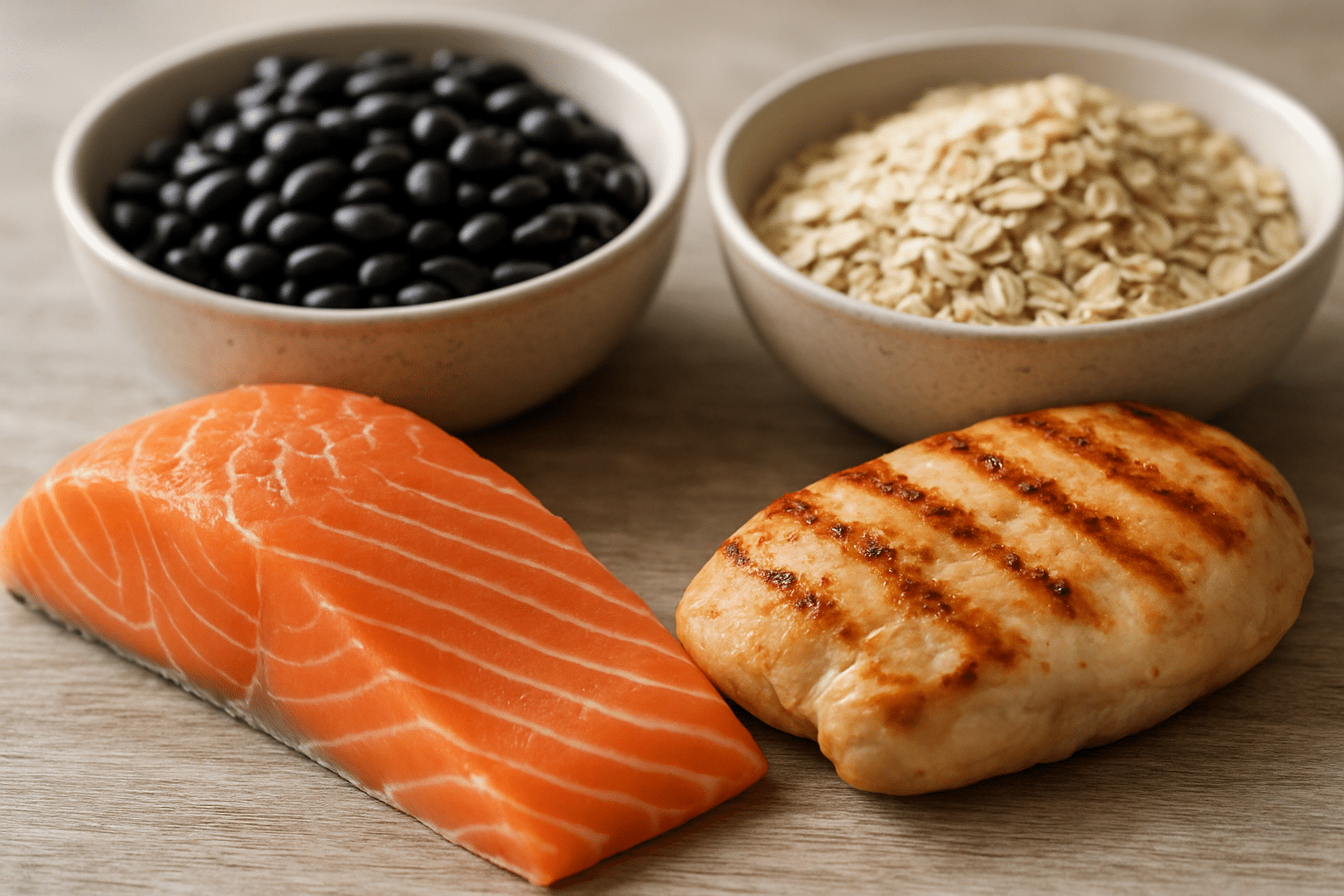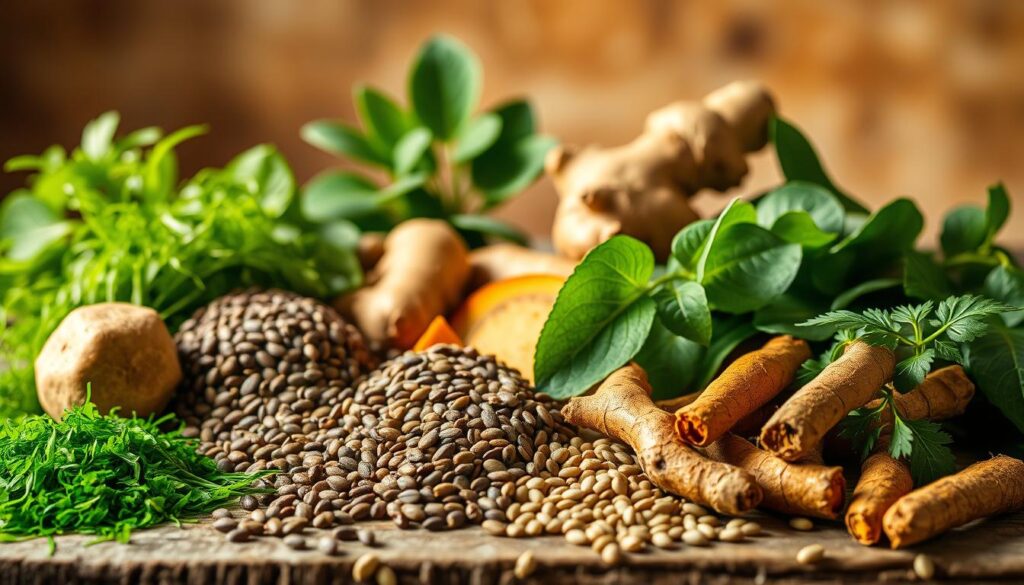Anúncios
This article shows practical, evidence-based ways to boost skin collagen using a collagen-rich diet and foods for skin elasticity. You’ll discover which natural foods rich in collagen supply building blocks directly and which plant-powered choices help the body make more collagen for glowing skin.
The focus is adults in the United States who prefer noninvasive, diet-based approaches to improve skin firmness, reduce fine lines, and support overall radiance. Scientific consensus from sources like the American Academy of Dermatology and the National Institutes of Health notes that collagen is a structural protein essential to skin integrity, and that diet and lifestyle affect collagen quantity and quality.
Anúncios

Natural Foods Rich in Collagen
Expect clear sections on foods that contain collagen, plant nutrients that support collagen synthesis, bone broth recipes, supplement guidance, and lifestyle habits that enhance results. You can jump to recipes, supplements, or meal plans depending on your needs.
Key Takeaways
- Natural foods rich in collagen and a collagen-rich diet can help support skin structure and elasticity.
- Some foods supply collagen directly; others provide the vitamin C, amino acids, and minerals needed to boost skin collagen.
- Bone broth, fish, poultry, and certain plant foods are practical choices for collagen for glowing skin.
- Diet works best with sun protection, sleep, and stress management to preserve collagen.
- Further reading from the American Academy of Dermatology and NIH can help you explore the science behind these recommendations.
Why Collagen Matters for Skin Health
Collagen is the main structural protein in skin. It creates a firm scaffold in the dermis that gives shape and strength. Fibroblasts produce mostly type I and type III collagen, which work with elastin and hyaluronic acid to keep skin plump and hydrated.
Role of collagen in skin structure and elasticity
In the dermis, collagen fibers form a woven network that resists stretching and supports the epidermis above. That network affects skin elasticity collagen by limiting sag and preserving contour. When collagen is abundant, skin bounces back more quickly after movement or pressure.
How collagen production changes with age
Collagen aging begins subtly in the late 20s. Natural synthesis drops about 1% per year, with faster loss after menopause in many women. External factors such as UV exposure, smoking, and poor diet speed degradation by activating matrix metalloproteinases (MMPs). Chronic inflammation reduces new collagen formation too.
Signs of collagen depletion to watch for
Early signs include fine lines, dullness, and less spring in the cheeks. As depletion progresses, you may notice skin laxity, visible sagging, slower wound healing, and thinning skin. Dermatological tests often show decreased skin elasticity and reduced dermal thickness as clinical signs of collagen loss.
Spotting signs of collagen loss early makes a practical difference. Dietary choices, sun protection, and lifestyle shifts can slow collagen aging and support repair when started sooner rather than later.
Natural foods rich in collagen
Good food choices can support skin structure and repair. This section outlines practical animal collagen sources, compares supplements with whole-food options, and explains how cooking affects collagen availability.
Animal-based sources: bone broth, chicken, and fish
Bone broth collagen comes from simmering bones and connective tissue. Slow-simmered beef, chicken, pork, or fish bones release gelatin, glycine, and proline. Adding a splash of vinegar helps draw minerals and collagen out of the bones.
Chicken offers accessible animal collagen sources in skin, wings, necks, and feet. Traditional recipes that use these parts yield rich, collagen-dense stock. Fish provides type I collagen in skin and scales. Marine bone broth made from heads and frames gives a different amino acid profile than beef or poultry.
Collagen peptides vs whole-food sources: what to expect
Collagen peptides and hydrolyzed collagen are broken into smaller pieces for easier absorption. Clinical studies often use daily doses between 2.5 and 10 grams and report improved skin elasticity and hydration.
Whole foods such as bone broth deliver collagen plus gelatin, minerals, and other amino acids. Serving sizes vary, so precise dosing is harder with foods high in collagen. Expect dietary collagen to supply building blocks that support the body’s own collagen synthesis. If you want predictable intake, supplements give consistent grams per serving.
How cooking and preparation affect collagen availability
Long, gentle simmering extracts gelatin from collagen without destroying useful peptides. Pressure cooking speeds extraction but can change flavor. High, prolonged heat may denature some proteins, yet gelatin remains functional for soups and stews.
Acidic ingredients like lemon or apple cider vinegar improve extraction during broth making. Cold marinades and quick cooking do not release collagen from bones and cartilage. Choose pasture-raised or wild-caught sources when possible to lower exposure to contaminants and improve overall nutrient quality.
Plant-powered nutrients that support collagen production

Plant-based foods supply key cofactors and building blocks the body needs to make and protect collagen. Eating a mix of fresh fruits, vegetables, legumes, nuts, seeds, and fungi helps deliver vitamin C, amino acid precursors, minerals, and antioxidants in meals you can enjoy daily.
Vitamin C–rich fruits and vegetables for collagen synthesis
Vitamin C is an essential cofactor for the enzymes that hydroxylate proline and lysine during collagen formation. Without enough vitamin C, newly formed collagen is weak, which is why extreme deficiency causes scurvy.
Top plant sources include oranges, grapefruits, strawberries, kiwi, bell peppers, broccoli, and Brussels sprouts. To maximize vitamin C collagen synthesis, eat these foods fresh or add lemon to warm dishes like bone broth right after cooking.
Amino acid precursors from legumes and nuts
Collagen requires specific amino acids: glycine, proline, hydroxyproline, and lysine. Plants do not supply collagen itself, but many provide the precursors needed for the body to build collagen.
Legumes, beans, lentils, chickpeas, soy products, nuts, seeds, and whole grains offer lysine and other amino acids for collagen. Combine complementary proteins, such as rice and beans, to boost the overall amino acid profile and support amino acids for collagen production.
Antioxidant-rich greens and berries to protect collagen
Oxidative stress speeds collagen breakdown. Foods rich in polyphenols, carotenoids, and flavonoids limit damage and help antioxidants protect collagen in skin and tissues.
Choose spinach, kale, Swiss chard, blueberries, raspberries, dark cherries, and green tea. Simple habits—adding berries to smoothies and steaming greens lightly—preserve nutrients and make it easy to include antioxidants protect collagen in everyday meals.
Micronutrients from plants and fungi
Copper and zinc are crucial for cross-linking collagen and supporting enzymes involved in formation. Pumpkin seeds, sunflower seeds, lentils, and chickpeas are good plant sources. Mushrooms contribute B vitamins that support cellular metabolism and tissue repair.
Mix seeds into salads, snack on almonds, and add lentils to soups to create balanced plates rich in plant nutrients for collagen.
Practical pairing tips
For better absorption and effect, pair vitamin C sources with plant proteins. For example, toss citrus segments into a spinach and lentil salad, or blend strawberries with soy yogurt and a spoonful of almond butter. These simple combinations boost vitamin C collagen synthesis, supply amino acids for collagen, and ensure antioxidants protect collagen at the same time.
Best seafood and animal proteins for promoting healthy skin
Choosing the right seafood and animal proteins boosts skin repair and resilience. Focus on oils, bones, cartilage, and mineral-rich shellfish to give your body building blocks for healthy skin.
Fatty fish like salmon and sardines deliver omega-3s that calm inflammation and help the skin barrier stay intact. The salmon collagen benefits come from skin and bones when you cook them gently, adding marine collagen and supporting hydration.
For budget-friendly options, canned sardines provide similar nutrients and vitamin D. Choose wild-caught when possible to reduce exposure to pollutants and get a cleaner source of nutrients.
Collagen-rich poultry and red meat cuts to favor.
Use parts rich in connective tissue for slow-cooked broths and stews. Chicken feet, necks, wings, and cartilage release collagen during long simmering. This chicken connective tissue is easy to extract into soups and makes a flavorful base for meals.
Beef cuts such as oxtail, shank, short ribs, and brisket contain tough connective tissue that melts into gelatin with time. Add these to bone broths or braises to maximize collagen yield and mouthfeel.
Seafood minerals that support collagen assembly.
Zinc and copper act as cofactors in collagen synthesis and cross-linking. Shellfish like oysters, crab, and lobster are concentrated sources of these minerals for collagen. Shrimp and many smaller fish add trace minerals for skin repair as well.
Balance intake by varying species and limiting large predatory fish to avoid mercury. Pair mineral-rich seafood with vitamin C foods such as citrus or bell peppers to help the body use those nutrients for collagen formation.
Practical serving ideas.
- Simmer chicken feet or beef shank into a clear broth for daily sipping.
- Grill salmon with skin on; use leftover bones to make a small marine broth.
- Serve oysters raw or lightly cooked with lemon to boost zinc absorption.
Bone broth and homemade collagen-rich recipes
Bone-based broths offer a simple way to support skin health through food. This section shows practical steps for how to make bone broth, ideas for collagen-rich soups and stews, and smart storage tips to keep homemade collagen broth safe and tasty.
How to make nutrient-dense bone broth at home
Start with bones that have connective tissue: chicken carcasses, beef knuckles, or fish bones. Roast beef or chicken bones for extra flavor if you like. Place bones in a pot, cover with cold water, and add 1–2 tablespoons of vinegar or fresh lemon per gallon to help draw minerals out.
Bring to a gentle simmer and cook low and slow. Typical times: chicken 6–24 hours, beef 12–48 hours, fish 4–24 hours. Skim any foam in the first hour. Add onions, carrots, and celery in the last few hours so they lend flavor without clouding the broth.
Long simmering converts collagen into gelatin. Chill the finished stock; a well-made batch will gel as it cools. That gel indicates gelatin formation and a collagen-rich result.
Soup and stew ideas to maximize collagen extraction
Use bone broth as the base for simple recipes that boost nutrient variety. Try a chicken and vegetable bone broth soup with bell peppers and tomatoes for vitamin C, which supports collagen synthesis.
Make a beef oxtail stew with carrots, parsnips, and a handful of lentils or beans to add amino acid diversity. For a lighter option, simmer fish heads with ginger and scallions into a clear fish consommé.
These collagen-rich soups work well as daily meals. Swap grains, beans, or leafy greens to keep flavors fresh and nutrients balanced.
Storing and using bone broth for daily skin support
Cool broth quickly and transfer to airtight containers. Refrigerate for up to 4–5 days. For longer storage, freeze in portions: use ice cube trays for small amounts or 1- to 2-cup containers for soups and cooking.
Use frozen cubes to boost smoothies, sauces, and grains, or thaw a cup to drink warm each day for steady intake. Reheat to steaming temperature before serving to ensure safety.
Remember that nutrient yield varies by bone type, cooking time, and method. Treat bone broth recipe efforts as a nutritious complement to a balanced diet rather than a miracle cure.
Supplements and when to consider them

When diet and lifestyle leave gaps, targeted supplements can help support skin structure. Clinical trials show daily oral collagen peptides often improve skin elasticity, hydration, and reduce wrinkle depth after 8–12 weeks. Typical doses range from 2.5 to 10 grams per day. Results vary by study design, product source, and individual habits. Use supplements as an addition to a nutrient-rich diet, not a replacement.
Collagen peptides and hydrolyzed collagen: evidence overview
Randomized trials provide collagen peptides evidence for measurable skin benefits. Marine, bovine, and porcine sources have been tested. Marine collagen peptides may show higher bioavailability due to smaller peptide size, while bovine and chicken-derived products remain effective. Hydrolyzed collagen benefits include easier digestion and absorption compared with intact collagen proteins.
Study methods and endpoints differ, creating variability in outcomes. Typical improvements appear after consistent daily use for two to three months. Keep expectations realistic and pair supplements with vitamin C–rich foods that support collagen synthesis.
Choosing high-quality supplements and checking labels
Look for third-party testing from organizations such as USP, NSF, or ConsumerLab. Labels should clearly state source (bovine, marine, chicken), that the product is hydrolyzed or contains collagen peptides, and the amount per serving. Check for added ingredients and avoid unnecessary fillers or artificial additives.
Consider sustainability and sourcing. Wild-caught fish or grass-fed bovine options reduce environmental concerns. Read allergen information carefully if you have fish, shellfish, or soy sensitivities. Thoughtful choosing collagen supplement practices help ensure safety and value.
Possible interactions and safety considerations
Collagen supplements are generally well tolerated. Some people report mild gastrointestinal upset. Those with fish or shellfish allergies should avoid marine products. Vegans and vegetarians will need plant-based strategies that support collagen production rather than direct collagen intake.
No major drug interactions have been documented, but speak with a healthcare provider if pregnant, breastfeeding, or taking chronic medications. Remember that dietary supplements are not regulated like drugs, so product quality and claims can vary widely.
Lifestyle habits that enhance dietary collagen benefits
Good nutrition lays the groundwork for healthy skin. Pairing collagen-rich foods with consistent lifestyle habits makes a real difference in skin tone and resilience. Below are practical steps to help maximize food-based collagen gains.
Sleep, stress management, and their impact on skin repair
Quality rest fuels cellular renewal and supports sleep and skin repair. Aim for seven to nine hours nightly to help fibroblasts produce collagen and to strengthen the skin barrier.
Chronic stress raises cortisol levels and speeds collagen breakdown. Simple practices like mindfulness, short guided meditations, and deep breathing lower stress and protect collagen while improving mood.
Sun protection and avoiding collagen breakdown
UV exposure activates enzymes that degrade collagen. To protect collagen from sun, use a broad-spectrum SPF 30 or higher, wear sun-protective clothing, and avoid peak midday sun whenever possible.
Topical antioxidants such as vitamin C serums complement sunscreen by neutralizing free radicals and reducing oxidative damage to skin proteins.
Exercise and circulation for nutrient delivery to skin
Regular movement improves blood flow and delivers nutrients and oxygen to skin cells. That boost helps skin cells maintain collagen and heal more efficiently, supporting exercise for skin health.
Include brisk walks, cycling, and two or three weekly strength sessions to preserve muscle tone that underpins skin structure. Hydrate before and after workouts to help circulation and skin function.
| Habit | What to do | Skin benefit |
|---|---|---|
| Sleep routine | Create a 30-minute wind-down, keep lights low, set consistent wake time | Enhances sleep and skin repair; supports collagen synthesis |
| Stress control | Try daily 10-minute mindfulness, breathing exercises, or journaling | Reduces cortisol-driven collagen loss and inflammation |
| Sun safety | Apply SPF 30+, wear hat and UPF clothing, avoid 10am–4pm sun | Helps protect collagen from sun and slows photoaging |
| Exercise plan | Mix cardio, strength training, and mobility 4–5 times weekly | Boosts circulation and supports exercise for skin health |
| Harmful habits | Stop smoking; limit alcohol to moderate levels | Prevents accelerated collagen degradation and dehydration |
Combining these habits with a collagen-supporting diet creates a practical lifestyle for skin collagen. Small, consistent changes build lasting results that complement what you eat.
Practical meal plans and snack ideas for glowing skin
Start your day with a simple plan that feeds skin from the inside out. This short guide pairs whole foods and easy prep so you can follow a collagen meal plan without stress. Use these ideas to build skin-healthy recipes that fit a busy routine.
Sample day: breakfast, lunch, dinner focused on collagen support
Breakfast: Greek yogurt parfait with mixed berries and ground flaxseed. Stir a scoop of hydrolyzed collagen peptide into your coffee or oatmeal for a protein boost.
Lunch: Salmon salad with mixed greens, bell peppers, orange segments, and pumpkin seeds. Dress with a bone-broth–based miso vinaigrette for extra amino acids.
Dinner: Slow-simmered beef oxtail stew with root vegetables and kale. Serve with quinoa or barley for whole-grain balance. Optional evening: warm cup of chicken bone broth with lemon.
Quick snacks and smoothies packed with collagen-building nutrients
Berry-spinach smoothie: banana, mixed berries, spinach, almond butter, a scoop of collagen peptide powder, and a splash of orange juice for vitamin C.
Hummus with raw bell pepper strips makes a crunchy, portable option that pairs lysine and vitamin C. A handful of almonds or pumpkin seeds plus a small piece of dark chocolate adds zinc and antioxidants.
Shopping list and pantry staples to keep on hand
Keep a short, practical shopping list for collagen diet prep. Stock animal proteins, citrus, leafy greens, legumes, nuts, seeds, and broth-making essentials to support fast assembly of skin-healthy recipes and collagen snacks.
| Category | Items | Why it helps |
|---|---|---|
| Animal proteins | Chicken carcasses, chicken feet, beef knuckles, oxtail, canned wild salmon, sardines | Rich in collagen and connective tissue proteins for broth and stews |
| Produce | Citrus fruits, berries, bell peppers, kale, spinach, carrots, onions | Provide vitamin C and antioxidants for collagen synthesis and protection |
| Legumes & grains | Lentils, chickpeas, quinoa, barley | Supply amino acids and fiber for balanced meals |
| Nuts & seeds | Almonds, pumpkin seeds, chia, flaxseed | Deliver zinc, omega-3s, and healthy fats to support skin |
| Broth & extras | Apple cider vinegar, bone-broth ingredients, herbs, extra-virgin olive oil | Aid collagen extraction and add flavor without processed additives |
| Supplements & staples | Hydrolyzed collagen peptides, vitamin C powder, green tea | Convenient boosts for days when whole-food options are limited |
Meal prep tips: batch-make bone broth and stews, freeze portions, prewash and chop vegetables, and keep collagen powder in a shaker for quick mixing. This approach turns a short shopping list for collagen diet success into everyday skin-healthy recipes and grab-and-go collagen snacks.
Conclusion
This natural collagen foods conclusion highlights a simple approach: pair collagen-containing animal foods like bone broth, salmon, and connective-tissue cuts with plant-based nutrients such as citrus, berries, legumes, and leafy greens. Together they provide the amino acids, vitamin C, zinc, and antioxidants your body needs to support skin collagen naturally and help maintain elasticity and resilience.
Remember that diet is only part of the picture. Good sleep, sun protection, regular exercise, and avoiding smoking are essential lifestyle partners for any dietary collagen plan. The dietary collagen summary is clear: consistent eating patterns and healthy habits amplify results and reduce collagen breakdown caused by UV exposure and stress.
Expect to see gradual, measurable improvements in weeks to months, not overnight changes. Try one actionable step this week — make a batch of bone broth or add a vitamin C–rich orange or kiwi to your daily routine — and track how your skin responds. For personalized guidance or before starting supplements, consult a healthcare provider, especially during pregnancy or if you have chronic health conditions.
FAQ
What is collagen and why does it matter for skin health?
Which natural foods actually contain collagen?
Can plant foods help my body make collagen?
How do collagen peptides and hydrolyzed collagen supplements compare to whole foods like bone broth?
How should I make bone broth to maximize collagen extraction?
How much bone broth or collagen should I consume for skin benefits?
Do cooking methods affect collagen availability?
Are marine collagen sources better than bovine or chicken collagen?
What micronutrients should I focus on to support collagen synthesis?
Are there safety concerns with bone broth or collagen supplements?
How long until I might see skin improvements from dietary changes or supplements?
What lifestyle habits help collagen remain intact and functional?
Can vegetarians or vegans support collagen without animal collagen supplements?
How should I choose a collagen supplement if I decide to use one?
Can I get too much collagen or protein from these foods and supplements?
Any quick meal or snack ideas to support collagen-building nutrients?
Content created with the help of Artificial Intelligence.



